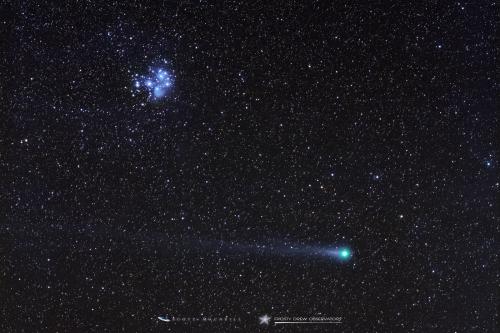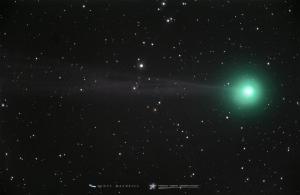A Comet for the New Year
Have you heard the recent buzz about the “New Year’s Eve Comet” in the media? Maybe a friend or family member told you about a blazing bright comet that will light up the sky beside the Moon on New Year’s Eve? Well the comet is Comet 45P/Honda-Mrkos-Pajdusakova (Comet 45P) and it will be 3° to the left of the Moon on New Year’s Eve for sure. Though contrary to much hearsay, it will not be visible to the naked eye. To catch a view, binoculars and/or a telescope will be required, but this is not a reason to skip out on a view or to back off the hype. Comet 45P has formed a beautifully long tail, as seen in recent photographs, and could become a fabulous comet in February 2017!
Comet 45P was discovered on December 3rd, 1948 and is a periodic comet that completes one full orbit around the Sun every 5.25 years. The solid center of the comet, called the nucleus, is only about 1 mile in diameter, though the atmosphere that forms around the nucleus due to vaporizing of gasses as the comet approaches the Sun, called a coma, can grow humongous. 45P will reach perihelion, its closest point to the Sun, on December 31, 2016 for its current orbital period. After which, 45P will begin its journey away from the Sun, bringing a close encounter to Earth on February 11, 2017 when the comet swings passed Earth at a mere 0.08 AU (7,732,000 miles) distant.
Viewing Comet 45P will be easy, if you know when and where to look. Contrary to popular banter, 45P will probably not become naked eye visible, unless an unexpected outburst occurs. The nights around New Year's Day will bring the potential to catch a binocular or telescopic view of the comet very low in the western sky around 6:00 p.m. The problem is that the comet is so close to the Sun that it drops below the horizon shortly after sunset, right at the end of twilight, and the brighter twilight sky will make the comet dimmer to our view and more difficult to see. The best viewing opportunities will actually happen during the second week of February in the early morning hours before sunrise. Though the comet will rock for a couple weeks in February, the bright Moon will accompany it from February 9th through February 16th. After which, the comet will move back into the evening sky. This leaves us with best viewing dates of February 6th - 8th at 5:00 a.m., with best photography dates continuing further into February after the Moon departs on February 16th.
Over the past few years, we have grown quite accustomed to a binocular or dim-naked-eye visible comet blazing our Holiday and winter time skies. It appears that Comet 45P will be our winter comet of 2017. Any comet that can be seen with binoculars is a comet to get excited about, though don’t expect to see a comet blazing across the sky on New Year’s Eve, and please do not mistaken Venus, which is extremely bright in the southwest sky this winter, as the comet. Best viewing will surely be in February, with an extended period of photo ops, but timing with the bright Moon will make for a short window of viewing opportunities. Regardless, welcome in the New Year and celebrate the winter with the night sky and maybe catch a view of Comet 45P/Honda-Mrkos-Pajdusakova.
- Author:
- Scott MacNeill
- Entry Date:
- Dec 30, 2016
- Published Under:
- Scott MacNeill's Columns



